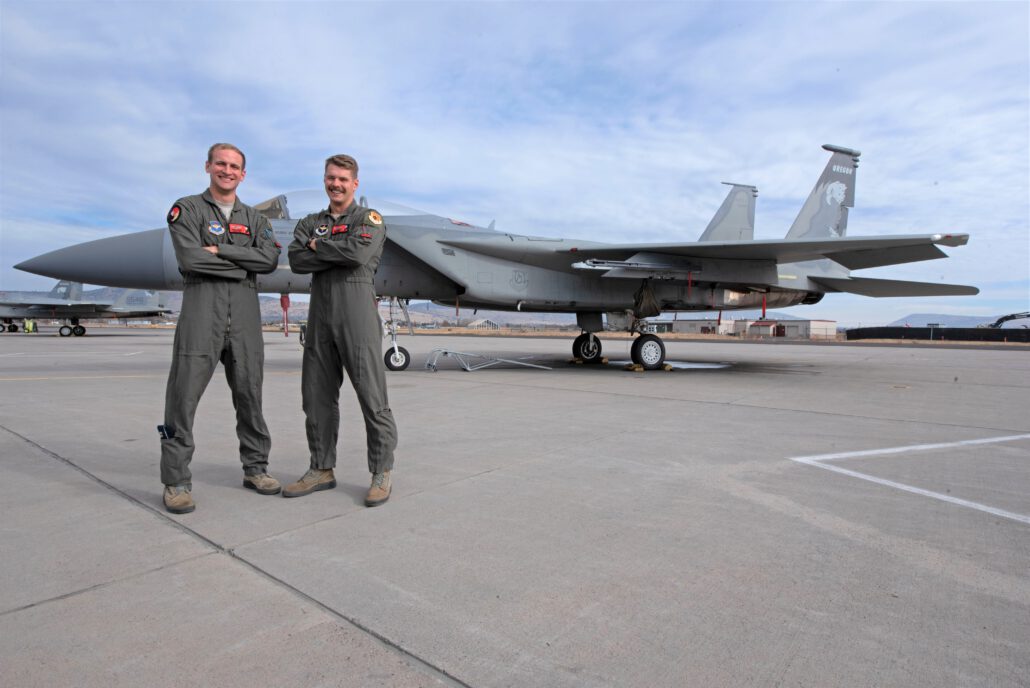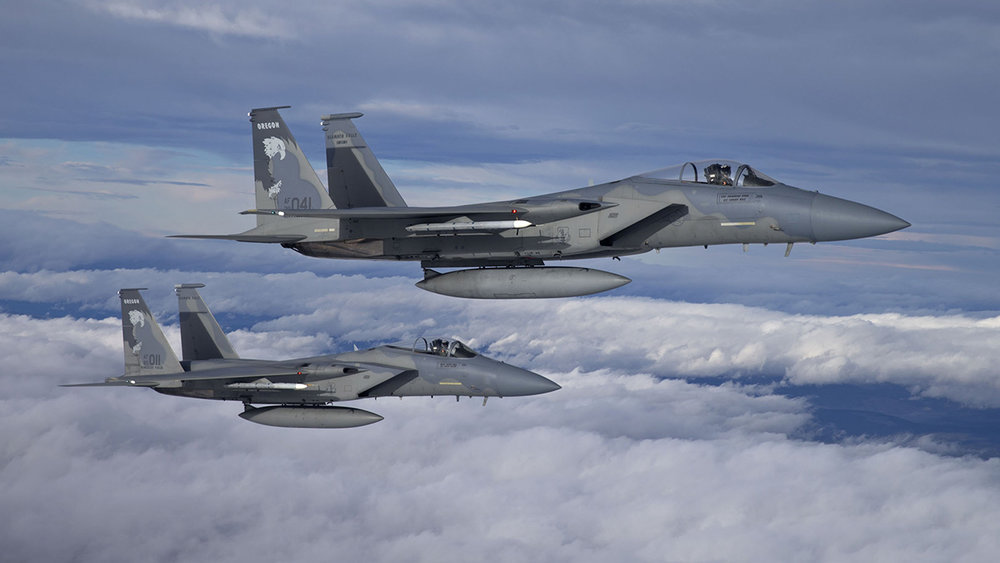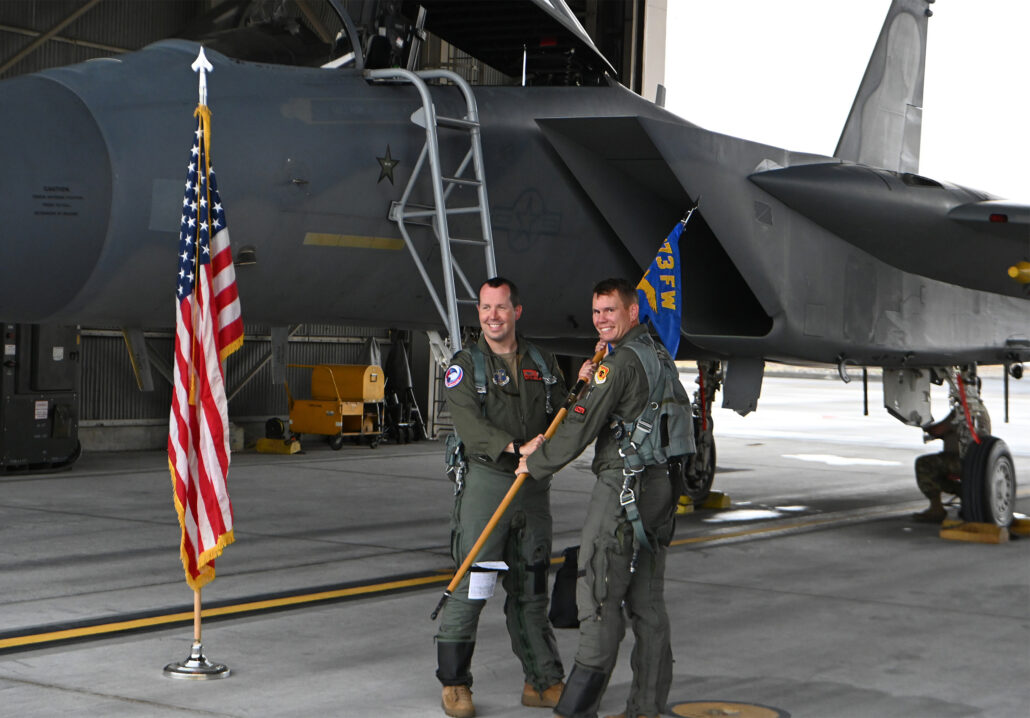Eagle’s Nest West “Land of no Slack”
Nestled in a quiet valley in Oregon is a little known place called “The Land
of No Slack.” Top sticks from around the Air Force are starting to flock to this new Mecca for “Eagle” superiority. A mythical place for bedtime stories? No, just the first training base in the Air National Guard for F-15 Eagle pilots. Currently all F-15 pilots are trained at Klamath Falls IAP taking over the active USAF Eagle training from Tyndall Air Force Base, Fla.
Located in Klamath Falls, the 173rd Fighter Wing at Kingsley Field Air National Guard Base is going through an unexpected aircraft conversion from pilot training in the F-16 to the F-15. An impossible mission? Not really, especially with the talent assembled to tackle the challenge.
The conversion at Kingsley Field actually began a few years ago when there was talk at the Pentagon about the need for additional F-15 training capability for the total force. The Air Force was considering an Air National Guard unit to fill that need.
“We were energized by that opportunity,” said Col. Billy Cox, 173rd Fighter Wing commander. So when the opportunity came to compete for the mission, Cox aggressively mounted a campaign to Washington, D.C. There he talked to Guard leaders to sell the organization as a potential site for the mission.
“Our biggest selling point was our experience in student pilot training production and the reduced cost of changing us rather than locating at some other locations,” said Cox.
Not too long afterward, the 173rd was given the thumbs up to go ahead. “We went in with our eyes open,” Cox said. “We knew the effort required us to convert to a new airplane. The work required of operations and maintenance to learn and maintain the jet was going to be significantly different than with the F-16.”
And Kingsley Field’s conversion is not your normal swap of one mission for another. When Lt. Col. Johnny Adkisson, 114th Fighter Squadron commander, first arrived in 1989, the wing was just finishing a conversion from the F-4 to the F-16. “That was a planned conversion that was budgeted. We had airplanes, equipment and everything a normal conversion has. Our new conversion is somewhat different,” said Adkisson.
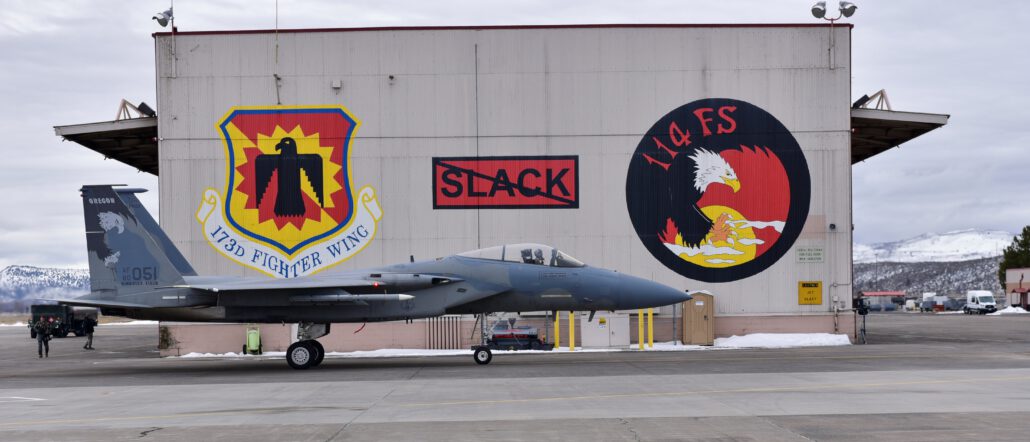
The Guard took a jet from each one of its six F-15 units, with two of those units providing one additional airplane. And that’s where the fun really started.
According to Lt. Col. Paul Weitlisbach, 173rd vice commander, there was no support equipment anywhere. Normally when a unit stands up in a planned conversion, another shuts down and provides the needed equipment. Not so in this case.
“Just having the ‘iron’ out there is nice. They’re shiny, and they look good in the sun. But if you don’t have all the support equipment that you need to fix the airplane, then it’s never going to leave the ground,” he said.
And a normal two- or three-day turnaround becomes eight days because of the need to send parts to Portland 300 miles away, where the 142nd Fighter Wing has F-15 avionics test stations. To help fix the problem, the 173rd sent teams to other F-15 units and the air logistics centers, to scrounge for parts and discarded equipment.
They took burnt-looking, twisted, broken pieces of equipment with holes in them and created something that works. “You talk about your $300 toilet seat. This is the complete opposite. We’re creating multimillion dollar test stations out of ‘garbage’ — spinning straw into gold,” Weitlisbach said. “This has been a Herculean effort by my people.”
And the 173rd’s maintenance team is so fired up about what they’ve accomplished that, according to Weitlisbach, “you literally have to kick them out the door to get them to go home at night. The taxpayer is getting a lot of bang for the buck with what we are doing here.”On the other side of the
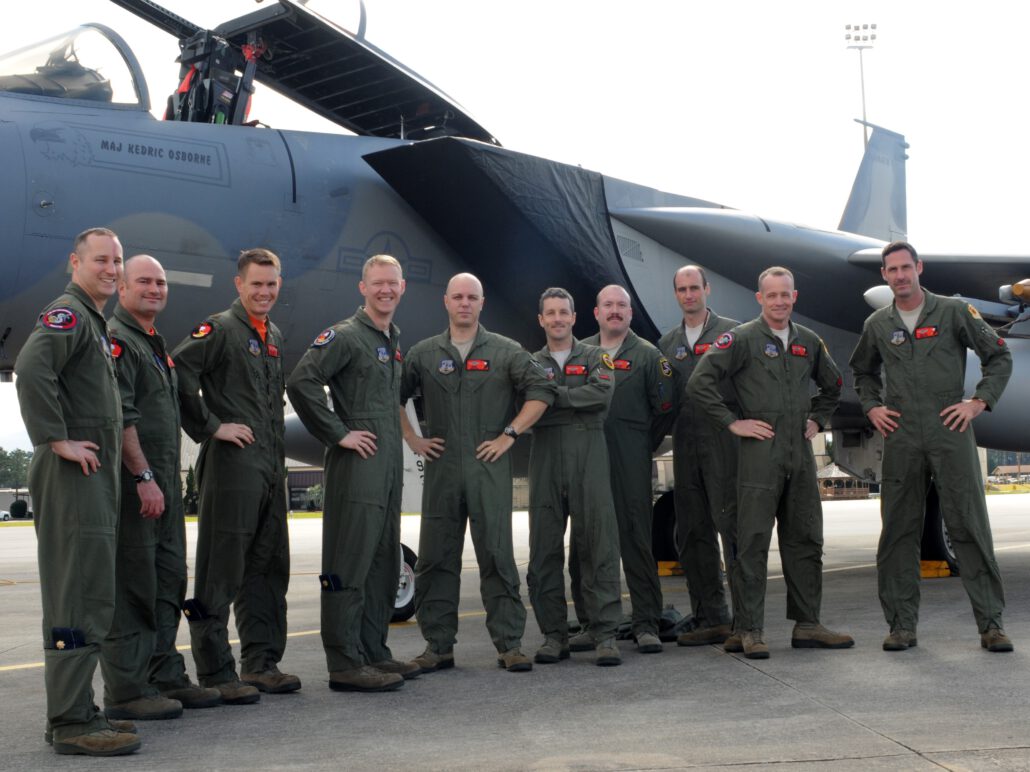
conversion challenge are the F-16 pilots who are just starting to get familiar with the F-15. “I’ll miss the F-16 because I like doing what I’m already good at,” said Capt. Matt Andrews, 114th Fighter Squadron instructor pilot.
“It’s like when you’re driving your car, you switch on the turn signal without even thinking about it,” Andrews said. “But when you get into an unfamiliar car, reach for that turn signal, and it’s not there anymore — you have to stop and think about it. When you have to stop and think, then you’re too slow. You’re not fighting, you’re not maximizing how you employ the machine.
“A lot of what we learned in the F-16 still applies — your basic smart fighter pilot tactics,” Andrews said. “We just have to retrain our fingers. We call it the ‘piccolo drill’ — where to put your fingers on the control stick and throttle to hit the “note” you want.
And the 114th FS has hit some high notes in the past. It’s well-respected in the fighter community for the training it accomplished with the F-16. “Training students is our life here,” said Adkisson. “We’ve been doing it since the place opened up. We’re set up for it. We have the facilities for it and the culture for it.
“Besides, we have thick skins. That’s why our sign in the hallway says the ‘Land of No Slack.’ ”
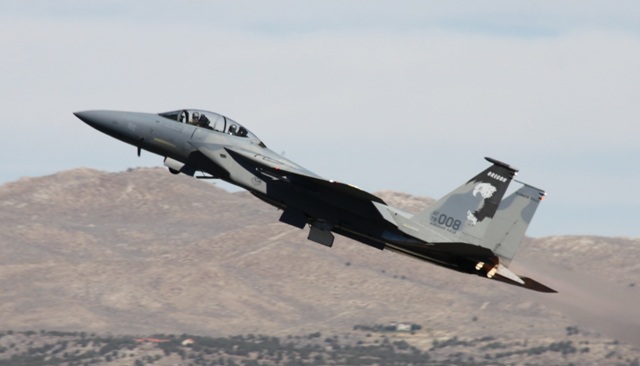
173rd Fighter Wing Eagles in Australia
by Master Sgt. Jerry Bynum
The 173rd Fighter Wing (FW) from Kingsley Field, Klamath Falls, Oregon started a flight exercise, “Sentry Down under”, on Monday, August 25 with the Royal Australian Air Force (RAAF) 2nd Operational Conversion Unit (OCU) located at RAAF Williamtown, New South Wales, Australia. Members of the 173rd FW arrived in Australia late last week and prepared for the arrival of Oregon Air National Guard F-15 Eagles from the 173rd FW and a KC-135 Stratotanker from the 141st Air Refueling Wing (ARW), Washington Air National Guard, Fairchild Air Force Base, Washington. The F-15s and KC-135 arrived at RAAF Williamtown on August 22.
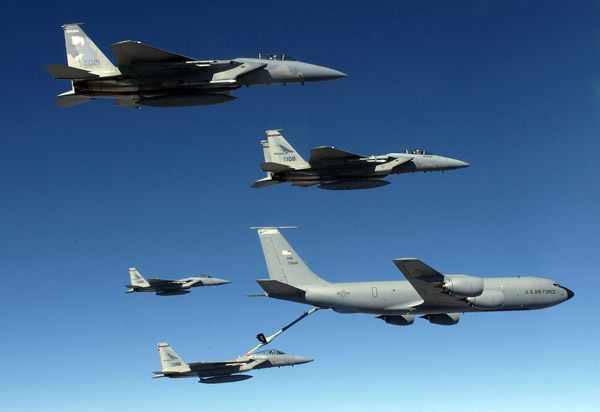
Like the 173rd FW, the 2nd OCU has a strong culture of training. The 2nd OCU trains RAAF fighter pilots as its primary role. They run the operational conversion courses for new pilots to the RAAF’s F/A-18 Hornet, operational refresher courses for former F-18 pilots returning to the aircraft, and fighter combat instructor courses to provide postgraduate qualifications for selected aircrew.
“Sentry Downunder” is a joint flight exercise with the 173rd FW assisting the RAAF 2nd OCU combat fighter instructor course with their advanced fighter weapons school. “This training gives us the opportunity to work with one of our closest allies,” says Major Brian Bergeron, 173rd FW project officer for the deployment. “Camaraderie was evident from the very first day; we train fighter pilots and we do the same things for the same reasons.” The RAAF F-18’s from the 77th Squadron (SQN), which is their operational squadron located at RAAF Williamtown, is also getting the opportunity to participate in the exercise.
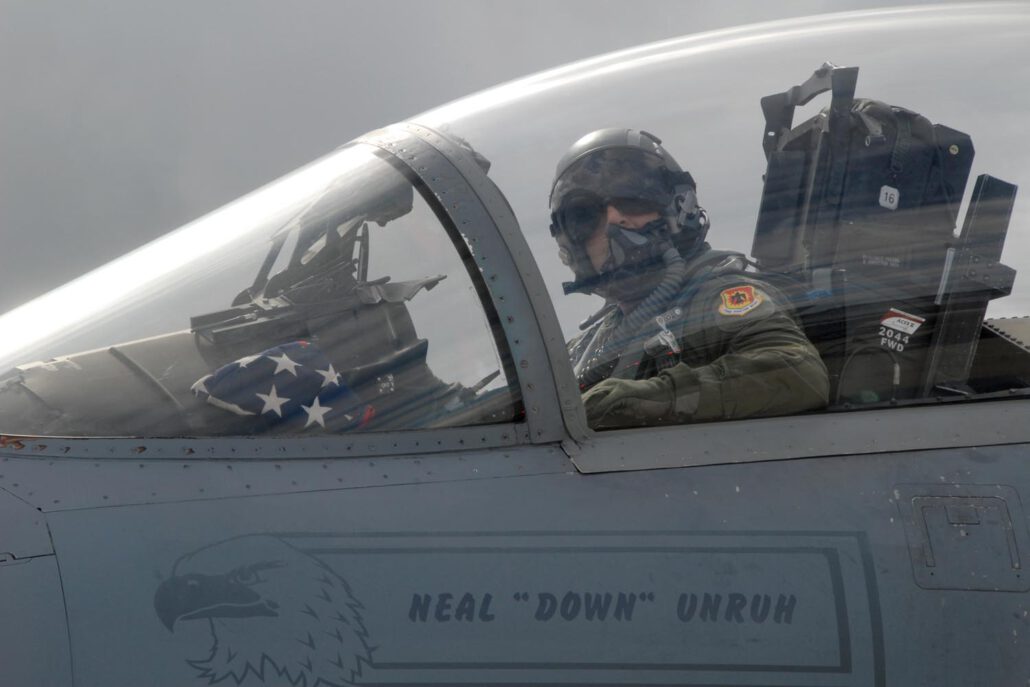
It has been a busy week of flying. During “Sentry Downunder” the 173rd FW has performed tactical sorties as well as familiarization flights. Forty-nine sorties were flown during the week with the 2nd OCU and the 77th SQN. Each sortie has included multiple training missions. “These missions are a great learning experience for everyone involved,” says Major Johan Deutscher, 173rd FW instructor pilot. “The RAAF gets an opportunity to look at the full capabilities of another airframe as well as train with seasoned instructor pilots.” The 173rd FW pilots bring a lot of experience to the exercise. On average, each instructor pilot has over 2,000 flight hours in the F-15. This experience provides a high quality training environment for the RAAF.
“The 173rd FW is bringing a high level of experience,” says Wing Commander Phil Gordon, RAAF 2nd OCU commander. “The Eagle pilots are really putting us through our paces with high quality fighting… I would love this training to happen as often as it can.” The 2nd OCU performs the same mission for the RAAF as the 173rd FW does for the United States, train combat fighter pilots. “The 173rd FW understands what we do,” says Gordon, “I couldn’t be happier with you guys coming out flying with us”.
During the exercise, 173rd FW is acting as adversary support for the 2nd OCU. This helps them meet their syllabus requirements for their advanced fighter weapons school. “Sentry Downunder” provides an avenue for the RAAF pilots to learn the Hornet’s strengths and weaknesses during dissimilar aircraft engagements. “The RAAF pilots are learning a lot about the capabilities of their aircraft during this training,” says Deutscher.
During the past week of tactical sorties, the fighters have been concentrating on one versus one basic fighter maneuvers; better know as “dog fighting”. This training focuses on close quarter combat where each aircraft is within sight of the other. Next week the tactical sorties will focus on long range tactical intercepts. The F-15 will simulate the Sukhoi SU-27 Flanker to provide different tactics required by the RAAF course syllabus. This training allows the RAAF to adapt their tactics to maximize their strengths.
Pilots from the 173rd FW and the 2nd OCU have also participated in familiarization “ride-along” flights in the F-15 and the F-18 respectively. This provides a unique opportunity for pilots to see, and “feel”, how the other jets fly.
In-flight tanker support from the 141st ARW has provided air-to-air refueling during the exercise. “We have flown in-flight refueling missions in support of the 173rd FW and the RAAF,” says Lt. Col. Kevin Littlemore, 141st ARW deployment commander. “It has been great to work with the RAAF; this exercise has provided a great opportunity for in-flight refueling training for our allies.” Not only is the tanker providing additional training, it is critical to provide the necessary fuel to accomplish the mission. Without the KC-135, flight sorties would be limited. “Tanker support is allowing us to conduct a training mission, refuel, and fly another training mission,” says Bergeron.
Not only has there been camaraderie in the air, but on the ground as well. This has been an opportunity for open communication and work with other aspects of the RAAF. The 173rd FW deployed maintenance package is getting the opportunity to interact with the different maintenance functions of the RAAF. “This has been a great opportunity to exchange maintenance practices and learn about different technologies that the RAAF are using, especially when it comes to aircraft servicing,” says Captain Micah Lambert, 173rd FW maintenance officer. “The exchange of ideas helps all of each of us improve the way we perform our jobs.”
The maintenance operations control center has to coordinate with the RAAF on a daily basis concerning maintenance issues and air traffic control. Other interaction includes the fuels management flight, which has had the opportunity to work side-by-side with the RAAF during ground refueling operations for the F-15. Each area has had an opportunity to work with their respective counterpart in the RAAF.
Flying will continue through next week and conclude on Friday, September 5. “Training with the Australians has provided our instructors, maintenance, logistics, and support personnel with a better understanding of our allies and their capabilities,” says Colonel James Miller, 173rd FW commander. “The mission and our very supportive hosts have been wonderful… the lessons learned will prove invaluable in the years ahead.”
Kingsley Field Ready to Accept all F-15C Training
9/13/2009 – Sept. 13, 2009 — KLAMATH FALLS, Ore. — The Air Force has decided to merge its active-duty F-15C training with the Oregon Air National Guard.
The merger comes as Air Education and Training Command adjusts to the drawdown of F-15 fighter aircraft following Defense Secretary Robert Gates recommended phasing out 112 of the service’s 405 in current use, said Col. Jeff Kendall, deputy director for flying training at AETC Headquarters, in a recent interview with Air Force Times.
The 173rd Fighter Wing currently shares the training mission with the 325th Fighter Wing at Tyndall Air Force Base, Fla. however the planned merger would leave the Klamath Falls base as the sole provider.
“As a wing, we are prepared to accept all of the F-15C training for the Air Force and Air National Guard if or when the Air Force makes that decision,” said Col. James Miller, the 173rd Fighter Wing commander.
Currently AETC has not said what they plan to do with the crew chief apprentice course, which provides the final step for student crew chiefs as they move join the operational Air Force, but Kendall says Kingsley Field is one option.
“Recently, we received correspondence that AETC had done two site visits to determine which locale would assume the crew chief apprentice course and apparently, AETC has opted to continue that training mission at Seymour Johnson AFB, N.C.,” said Miller. “It has gone forward for formal coordination although a final decision has not been made yet.”
Until now Tyndall AFB has trained approximately 60-80 pilots in a given year and the 173rd over 40 . According to Kendall that is approximately the number the Air Force will need following the draw down.
“Being the sole F-15 training base would not increase our flying hour program too dramatically,” said Miller. “We currently fly between 4,800 and 5,200 hours and we would be able to accomplish the F-15 training mission within those hours and are postured to fly more.”
Perhaps the most obvious sign of the merger for Klamath Falls residents will be four additional F-15 D-models which will increase the wing’s aircraft count to about 25, said Kendall.
Another piece of the shared training mission is air battle manager training.
“In the last two years, the 173d Fighter Wing has hosted approximately 80 air battle manager students and instructors in support of the air battle manager syllabus and we continue to work with AETC to maintain this support,” said Miller.
Tyndall AFB currently runs the new F-22 Raptor student pilot training course
Oregon Airmen train in Finland
By Tech. Sgt. Jefferson Thompson, 173rd Fighter Wing Public Affairs / Published May 18, 2016
KUOPIO, Finland — More than 100 Oregon Air National Guard Airmen from the 173rd Fighter Wing at Kingsley Field, Ore. traveled to Kuopio, Finland for a training opportunity between two partner countries.
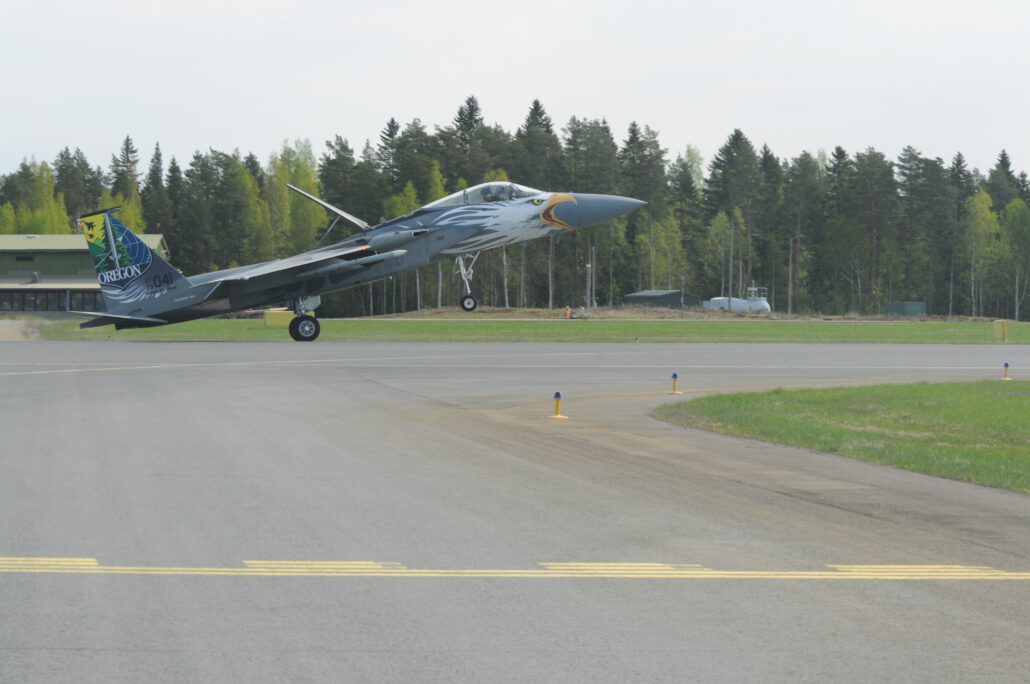
The exercise is part of Operation Atlantic Resolve, but differs from other deployments to the region called theater security packages in that it is really a training opportunity between partner nations–Finland and the United States.
The 173rd Fighter Wing is the sole F-15C training unit for the United States Air Force, and its main mission is to introduce Airmen to the F-15C for the first time or requalify pilots from non-flying positions or other airframes. 173rd Fighter Wing Commander Col. Jeff Smith said that expertise proved valuable in this environment.
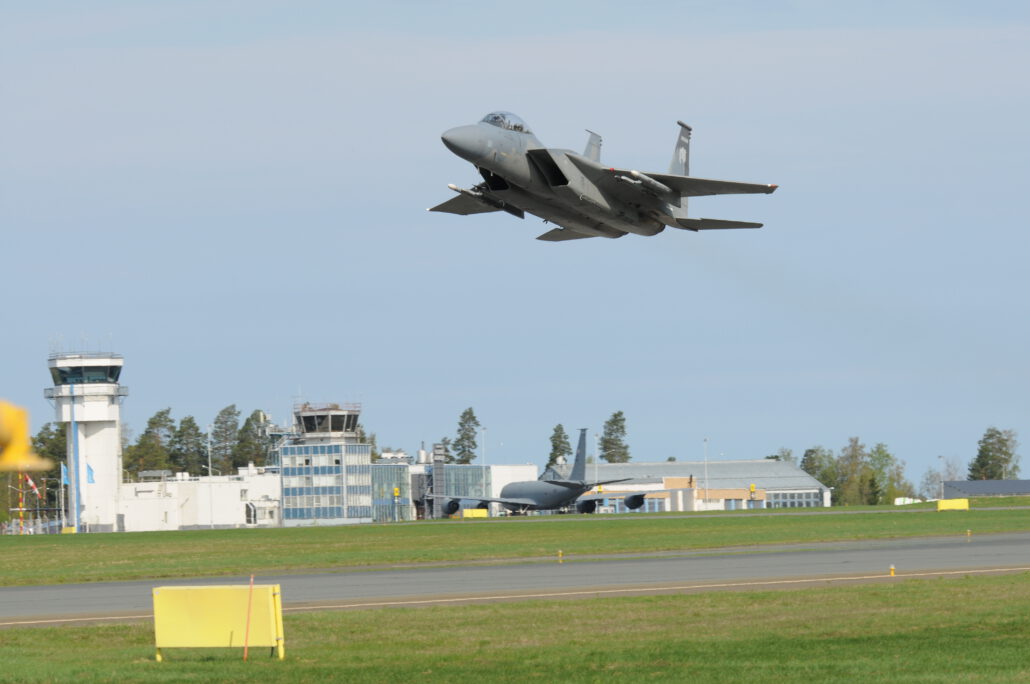
“At home with our students we use a building block approach beginning with one-verses-one scenarios and progressing to two-verses-two and so on, and that format is how we are conducting this exercise beginning with the smallest block, getting familiar with each other’s tactics and working to cross the language barrier,” he said. “By the end of next week we’ll be training in large force exercises, possibly as many as eight-verses-eight.”
Lt. Col. Alaric Michaelis, 173rd FW F-15 instructor pilot, says that in more than 19 years of flying the F-15 this training experience is near the top.
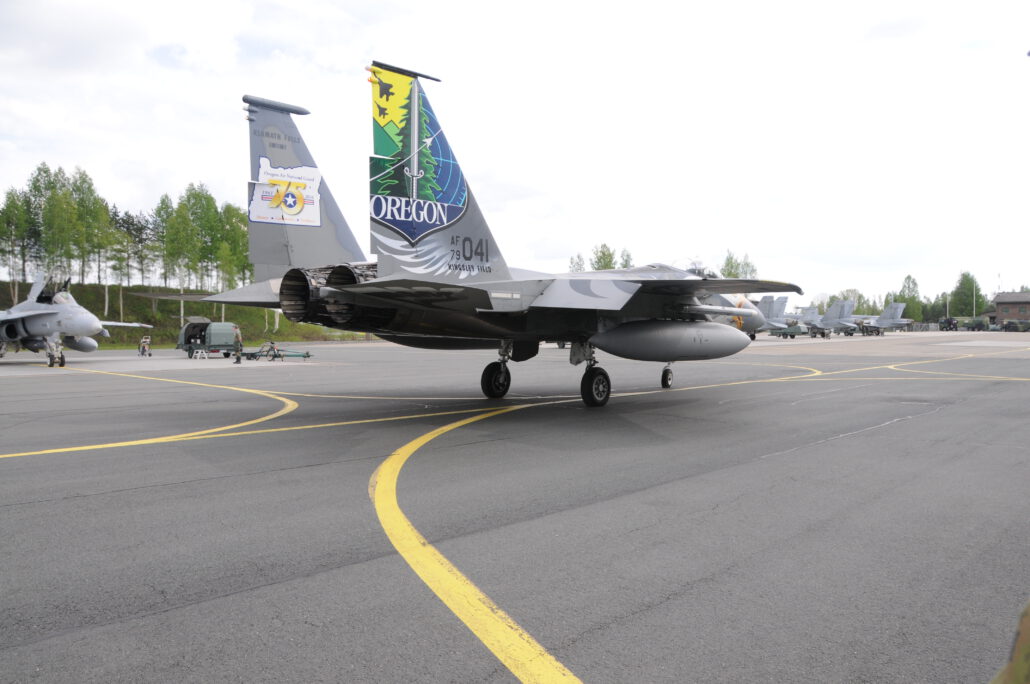
“The fighter pilots from Finland are the best international fighter pilots that I, in my career, have flown with,” he said. “It’s not just their ability, but their want, their tenacity, and their grit to get better.”
Another high point the American pilots are quick to point out is the first-class way the Finns have welcomed them.
“Personally this has been my favorite trip I’ve ever been on,” said Maj. Kevin Welch, an instructor pilot with the 173rd Fighter Wing. “To see the work ethic of the younger guys–to see the intensity of the older guys to help make them better is amazing!”
Over the final week of the training exercise the Finns and the Americans will practice a large scale exercise against the Swedish air force; Welch says it will put to the test everything they have learned in the last 10 days.
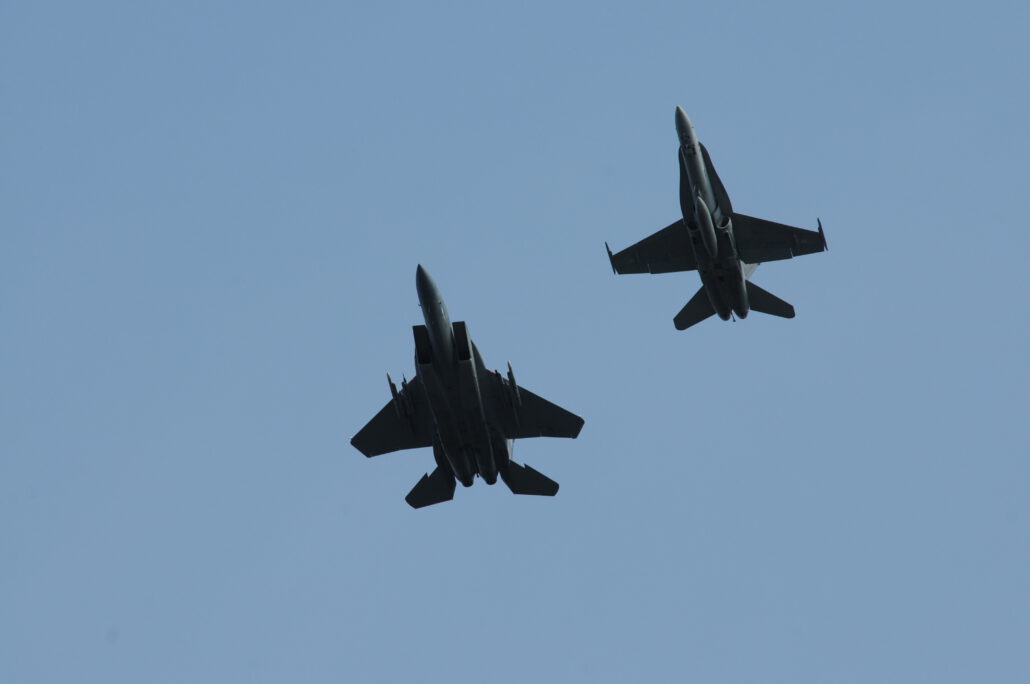
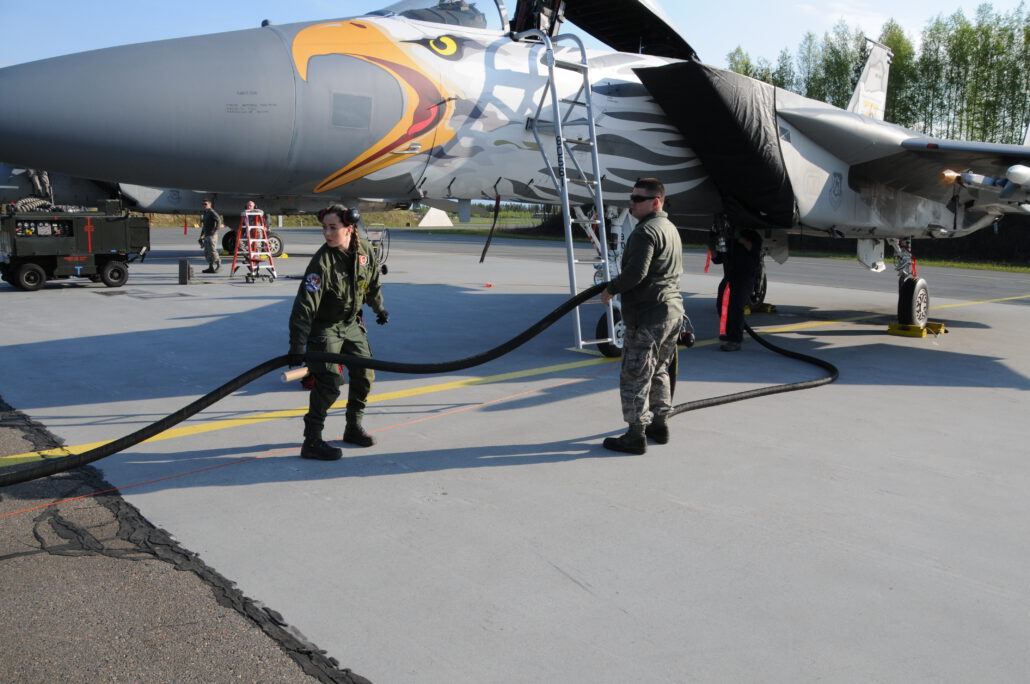
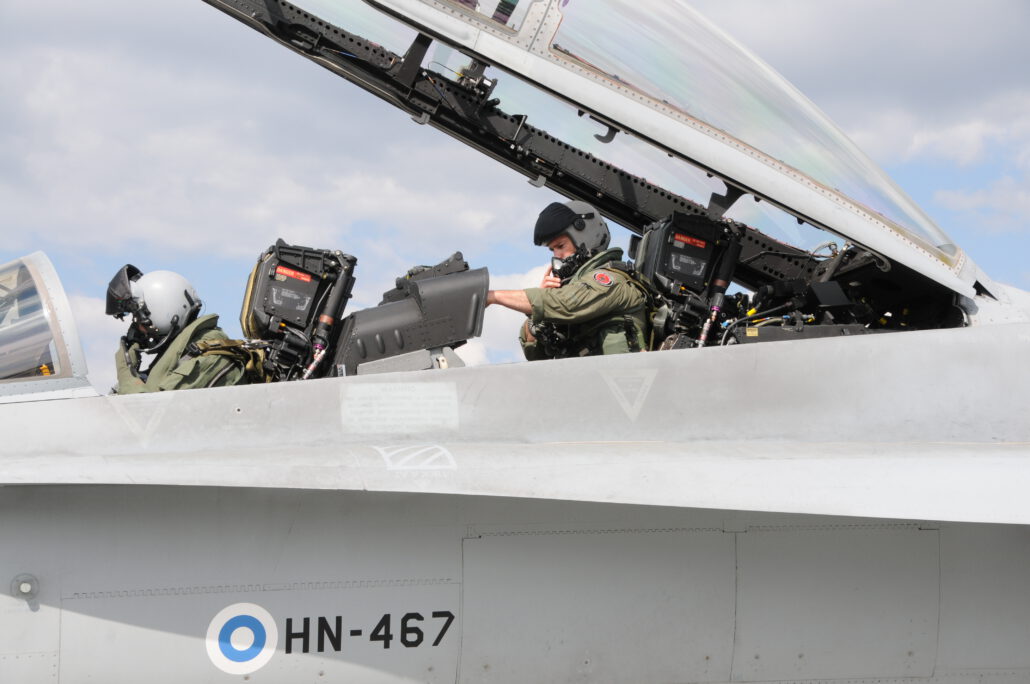
Squadron photos
